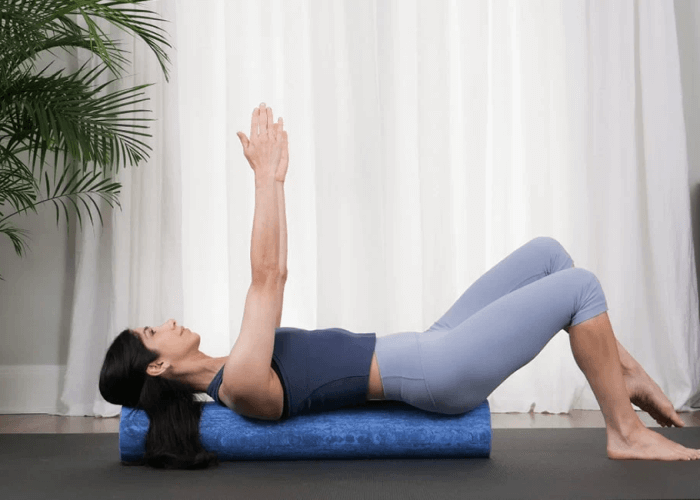How Panoramic Vision Can Reduce Your Stress And Anxiety

You know how GOOD it feels when your eyes look out over an ocean at that faraway horizon? And what about all those Instagram photo ops at great heights or in remote locations that make us drool?
There is something more to these locales that light us up than just a pretty view — we actually have a physiological response when we tap into panoramic vision.
What Is Panoramic Vision?
It turns out that our eyes can do more than just take in the sights of the world around us! As neuroscientist, Andrew Huberman from Stanford University shared on his podcast, how we focus our eyes is closely linked to the internal stress levels we feel.
Research shows that our stress levels decrease in panoramic vision — that means looking straight ahead and allowing peripheral vision to open up.
Unlike when we are visually focused on one thing (like a computer screen) in panoramic vision, our ability to see detail fades. Instead, panoramic visions allow us to see the bigger picture, boosting our reaction time and mellowing our “flight or flight” response to stressful situations.
You don’t need to practice your panoramic vision exercises frequently to see the difference in your stress levels, either.
Huberman recommends spending 2-10 minutes daily in panoramic vision to have the most significant impact.
How Does Vision Impact Stress Levels?
How you’re viewing something can stress you out.
According to Scientific America:
When you see something exciting or stressful—a news headline, a fraudulent credit-card charge—heart rate increases; breathing increases.
One of the most powerful changes is with vision. The pupils dilate, and there’s a change in the position of the lens in the eye.
Your visual system goes into the equivalent of portrait mode on a smartphone — your field of vision narrows. As a result, you see one thing in sharper relief, and everything else becomes blurry.
Your eyeballs rotate just slightly toward your nose, setting your field depth and focusing on a single location.
This is a primitive and ancient mechanism by which stress controls the visual field.”
In English, this means our vision naturally narrows when we are stressed. However, when we look up panoramically we override this default stress response and can start calming down on a psychological level.
Panoramic Vision for Eye Fatigue
When I was training clients in my Dilworth Artisan Station studio, I had the great fortune to have a wonderful and spacious view of uptown Charlotte.
In the days before development increased and new buildings sprung up, the view was wide open. I had the Wunda Chairs, one of the pieces of Pilates apparatus, placed so that one could look out while doing standing leg pumps.
I used to cue clients to look out into that spaciousness in order to free up the neck and give more length to the spine.
The change for them, and even for me as I would cue it, would immediately create better alignment.
“Look out at an imaginary horizon” is a pretty standard directive I will give someone to improve head and neck alignment.
Now, after listening to Huberman’s Instagram posts and podcasts, I use this shift in focus much more consciously and purposely for more than just an alignment fix.
I will shift into panoramic vision periodically when I can feel eye fatigue from computer work, a build-up of stress, or when I can feel a negative thought pattern that wants to take hold.
The Power of Awareness
Now, pause right HERE, right NOW.
Really!
Notice how your eyes are focusing on reading these words. Don’t shift a thing. Take note of the shape and feel of your body, especially the muscles in your shoulders, upper back, and neck area.
For comparison, take a moment to look at an open area around you. For example, look through an open doorway or window and let your gaze expand.
Don’t focus on one object but allow your gaze to be soft. Observe how your body responds to this shift. Notice your breath.
If you went along with the experiment, I guess you probably felt your posture change when you switched to the open, panoramic gaze and took a nice conscious breath that felt good?
Now you’re seeing the power of panoramic vision in action.
5 Vision Exercises
Just as our bodies will adapt to repetitive postures and movements, so will the muscles and tissues of the eyes.
For example, our habitual use of screens can cause us to lose full range of motion and cause or worsen near-sightedness.
We can improve our eye health and function with eye exercises.
Try these five simple eye exercises for better eye health and comfort.
1. All Directions Exercise
Slowly explore the full range of motion of your eyes moving up and down, side to side, on each diagonal, and in semi-circles (the top and lower half separately).
For an extra bit of insight, record yourself. Notice if your head is moving along with your eyes.
Ideally, you’ll be able to differentiate the movement of your eyes from the movement of other body parts. You can do this exercise with your eyes closed and open.
Eye Exercise Tips:
- Move slowly with no more than 4 repetitions at a time before bringing the gaze back to neutral. This will help prevent dizziness.
- If you have a history of vertigo, check with your physician to be sure this exercise is right for you.
2. Near to Far Focus
Alternating between near and far focus helps to train your focusing system to engage and relax appropriately.
Hold a pen near your face. Now, focus on a static object in the distance. Then, alternate your focus back to the tip of the pen.
You can also straighten and bend your arm keeping your focus on the moving tip of your pen. Try moving in your arm from side to side and in slow circles changing the closeness of your pen.
3. Swing
Similar to the benefits of the near-to-far focus exercises, trying this eye exercise in conjunction with a full body movement is an A+ in the overall wellness department.
- Stand with feet wide apart and arms relaxed.
- Begin to gently twist and swing your upper body from left to right.
- Begin to shift your weight from foot to foot allowing your hips and legs to come along.
- Soften your focus to create a blurred view, as if the objects in the room are moving.
- You can do this for 30 seconds to a minute.
- Note: You may need to start with a shorter time and work your way up.
4. Use Imagery
I often use a cue with yoga and pilates students: "Soften your eyeballs.”
While “soften your gaze” is more elegant, saying it this way often elicits a laugh with the realization of the tension there.
Maybe it’s due to stress from work, thoughts, or traffic. But sometimes, we need a simple reminder (or giggle) to relax the muscles around our eyes.
Take short breaks to close your eyes, and visualize your eyes as soft, pillowy clouds.
Or, imagine the muscles of your eyes as clenched fists that are softening and opening. A sense of relaxation and warmth will spread throughout your entire face.
5. Blink
When we use our focus in close range, we tend to blink less, causing dry eyes and discomfort.
Besides stepping away and taking frequent breaks, we can also increase awareness and blink more consciously during near tasks.
This allows natural stimulation of our eyes’ tear ducts.
Why does it matter? The coating of tears helps sharpen your vision, clearing and brightening the image your retina receives.
Blinking also nourishes your eye with oxygen and nutrients, keeping your eyes healthy and comfortable.
I hope this inspires you to take a fresh look at how you approach full-body exercise.
Improve your health and well-being with more instruction with private training or in my on-demand classes. HOW we move makes all the difference. Simple cues that open your awareness is key. For more info about training, click here! Or email me at sandvistudio@gmail.com.
Here’s looking at you!
Let's Stay In Touch!




